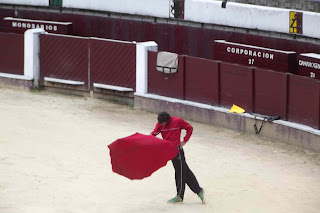 |
| Bagged, man! Suffering Carlos Martinez Silva in Parque de la Independencia. |
Recently during bike tours, several people have asked why this man, great enough to be immortalized in stone in the Parque de la Independencia, was wearing a black plastic bag over his head.
We pass by these stone heads every day. Undoubtedly famous back in their time, they're now been practically mummified in marble. This question pulled this particular stone man out of anonymity for me - but didn't provide any solid answer.
 |
Carlos Martinez Silva back in
the days when nobody would
have dared put a bag over his head. |
It turns out that
Carlos Martínez Silva (1847-1903) was quite an accomplished fellow: A writer, military leader, journalist and diplomat (he led a group which tried to negotiate a deal to dig the Panama Canal back in the 1880s, when Panama was still Colombia's. If the deal had succeeded, Panama would likely still be Colombian today, and Colombia would possess lots more global geopolitical and economic importance.
Martinez Silva was also a
hard-line Conservative, which could be a clue to his bagging. The Conservative-Liberal political divide was the fault line which cut thru Colombian during most of its history, generating several civil wars, as well as heated elections. Martinez Silva so represented the Conservative side, that the Liberals imprisoned him for several months during the Thousand-Day War.
Martinez Silva served as
dean of the very Catholic Rosario University, in La Candelaria. There, he earned the nickname
'Torquemada,' after a notoriously conservative Spanish inquisitor who burned thousands of heretics, Jews and Moslems at the stake.
This isn't the first time that a memorial to Martinez Silva has suffered such an indignity. In 1996, a
stone bust in his birthplace of San Gil was decapitated by a teenager.
Could century-old resentments have motivated somebody today to bag Martinez Silva's stone head? Or, was his bust in Independence park just a convenient symbol of authority?
Only the bagger knows.
A few other noteworthy monuments in Bogotá:
Francisco de Trujillo, in the National Park. A Spanish explorer and conquistador, he's remembered for having 'discovered' the Amazon River - even tho many people already lived along it.
Vladimir Lenin, in the 'Lenin Plaza' on the National University's campus. Lenin looks self-important, but none-too-happy, perhaps because his ideas have lost favor nearly everywhere except this little corner of La Nacho in Bogotá.
Ricardo Palma, on Avenida Jimenez, in front of the Las Aguas Church. Palma was an accomplished Peruvian writer. But I'd like to know what he's doing in the center of Bogotá.
Gabriel Betancur Silva, beside the Las Aguas TransMilenio station. This is one of Bogotá's newest statues. This genial-looking man brought student loans to Colombia.
By Mike Ceaser, of
Bogotá Bike Tours





















































